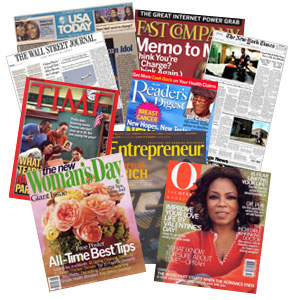 Since the advent of digital distribution, many traditional print publications — some venerable institutions that have been around for more than a century — have gone the way of the dodo bird. Despite the growth of e-readers and tablets, consumers continue to feel more positive toward print advertising than digital media, according to the Magazine Media Fact Book. When deciding how you should allocate your advertising dollars to best promote your product, keep in mind there are a few pros and cons to print media.
Since the advent of digital distribution, many traditional print publications — some venerable institutions that have been around for more than a century — have gone the way of the dodo bird. Despite the growth of e-readers and tablets, consumers continue to feel more positive toward print advertising than digital media, according to the Magazine Media Fact Book. When deciding how you should allocate your advertising dollars to best promote your product, keep in mind there are a few pros and cons to print media.
Pro: Drives Purchase Intent
According to the Readership Institute at Northwestern University, advertising is one of the top five drivers of newspaper consumption. On the magazine front, almost two-thirds of readers say they enjoy reading magazine ads, while more than half read their favorite print magazines specifically to gain information about new brands. Consumers enjoy and trust print advertising. At a time when consumers are fast-forwarding or bypassing advertising altogether, print media is considered a destination for advertising.
Pro: Cost, Lifespan, Production
Newspaper advertising can be less expensive than advertising in other media outlets. With different ad sizes and rates, even small businesses can place an ad that won’t break the budget. If your ad requires production changes, they can generally be made quickly. Ad design services are usually free. In addition, magazines and other print media enjoy loyal audiences. Magazines may be kept around for a month or longer, which gives more exposure to your product.
Pros: Targeted Audience
Print media provides opportunities to advertisers to reach targeted audiences in a local market. When you advertise your small business in local print media, you can focus your ad to fit your desired demographic. For instance, if you want to reach the Asian market, advertising in an Asian publication can generally achieve better results than advertising on other platforms because the readers are a high concentration of your target market.
Cons: Readership Decline
A decline in readership of print media has occurred as more people get their information and advertising from online sources. The firm eMarketer estimates that online newspaper advertising revenue grew more than 8 percent in 2011, while print newspaper advertising revenue sank more than 9 percent in the same year. It is generally a good strategy to spend your advertising budget where your audience is looking.
Con: Rates, Lead Times
While it’s true newspaper is a cost-effective advertising medium, when it comes to magazine advertising, especially in a national publication, the cost can be prohibitive. Furthermore, the magazine industry has long lead times, so your message cannot be delivered as quickly as with other media.
Con: Cluttered Landscape
In print media, your ad may be packed like a sardine among other advertisements, a very common practice in print media. It may be harder for your potential customer to find or read about your product.
This article comes from smallbusiness edit released
